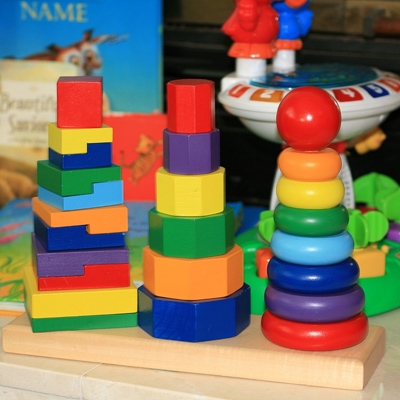Feeding Toddlers
From ages 1 to 3 years, toddlers will begin eating more solid foods. Learn about types, quantity, and times to provide food for toddlers.
Your child is now learning to eat more solid foods and is more active. Good nutrition gives your child what he or she needs for growth, health, and energy for playing, moving, and learning. Here are a few suggestions to help you feed your toddler.
What should my toddler be eating?
The toddler years are full of exploring and discovery. The best thing you can do is offer your toddler a variety of foods from each food group with different tastes, textures, and colors.
How much should my toddler be eating?
Your job is to decide what foods are offered and when and where they are eaten. Let your child decide which of the foods offered he or she will eat, and how much to eat. Day-to-day and meal-to-meal appetite changes are normal. It is important that you don’t make your child clean his or her plate.
The following table gives guidelines for how much your toddler should be eating each day.
Grain Group: at least 6 servings each day
- 1/4 – 1/2 slice of bread
- 2-3 crackers
- 1/4- 1/3 cup cooked rice, pasta, or cereal
- 1/4 – 1/2 bun, muffin, or bagel
Fruit and Vegetable Group: at least 5 servings each day
- 1/4 – 1/3 cup cooked, canned, or chopped raw
- 1/4 – 1/2 small fruit/vegetable
- 1/4 – 1/3 cup juice (limit fruit juice intake to no more than 4 ounces per day)
Milk Group: at least 3 servings each day
- 1/2 cup milk or yogurt
- 1/2 – 1 ounce of cheese
- Note: You do not need to give your toddler low-fat foods.
Meat Group: 2 servings each day
- 1-2 ounces lean meat, chicken, fish
- 2-4 tablespoons dry beans and peas
- 1/2 – 1 egg
Fat Group: 3-4 servings each day
- 1 teaspoon margarine, butter, oils
Is there anything I shouldn’t feed my toddler?
It is important to avoid foods that may cause choking:
- Slippery foods such as whole grapes; large pieces of meats, poultry, and hot dogs; candy and cough drops.
- Small, hard foods such as nuts, seeds, popcorn, chips, pretzels, raw carrots, and raisins.
- Sticky foods such as peanut butter and marshmallows.
Always cut up foods into small pieces and watch your child while he or she is eating.
Also, your child may have some food allergies. The most common food allergies are milk, eggs, peanuts and other nuts, soybeans, wheat, fish, and shellfish. Many children grow out of food allergies. If you think your child might have a food allergy, talk with your doctor.
What do I do if my child is a picky eater?
- Offer new foods one at a time, and remember that children may need to try a new food 10 or more times before they accept it.
- Avoid “short order cooking.” Serve at least 1 food you know your child will like, but then expect him or her to eat the same foods as the rest of the family.
- Make food simple, plain, and recognizable. Some kids don’t like food that is mixed (like a casserole) or food that is touching.
- Never force your child to eat a food he or she doesn’t like. Offer multiple choices so that he or she can choose something he or she does like.
Additional tips:
- Set a good example of healthy eating for your child.
- Plan regular meals and snacks and give kids enough time to eat.
- Plan a quiet time before meals and snacks. Kids eat better when they are relaxed.
- Don’t use food as a reward.
- Involve your children in making the food.
- Use child-size plates, cups, forks and spoons.

